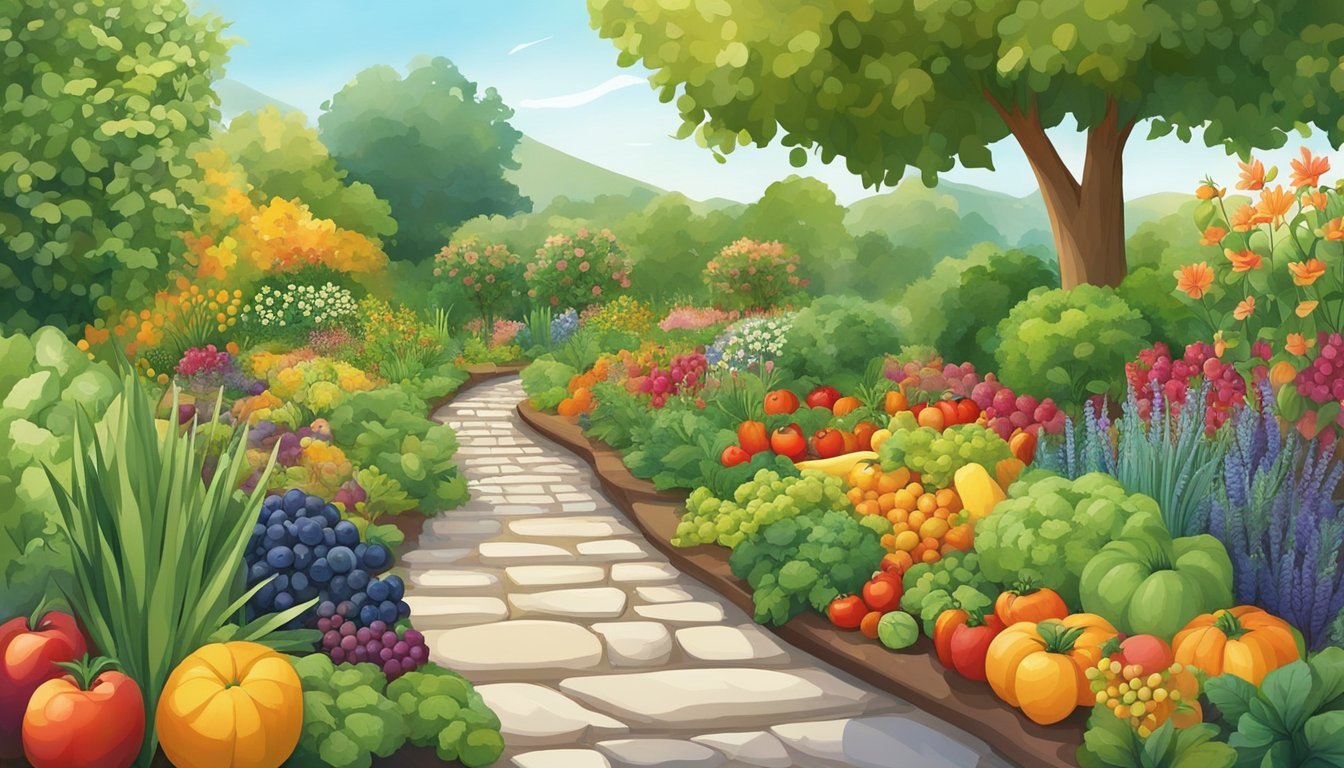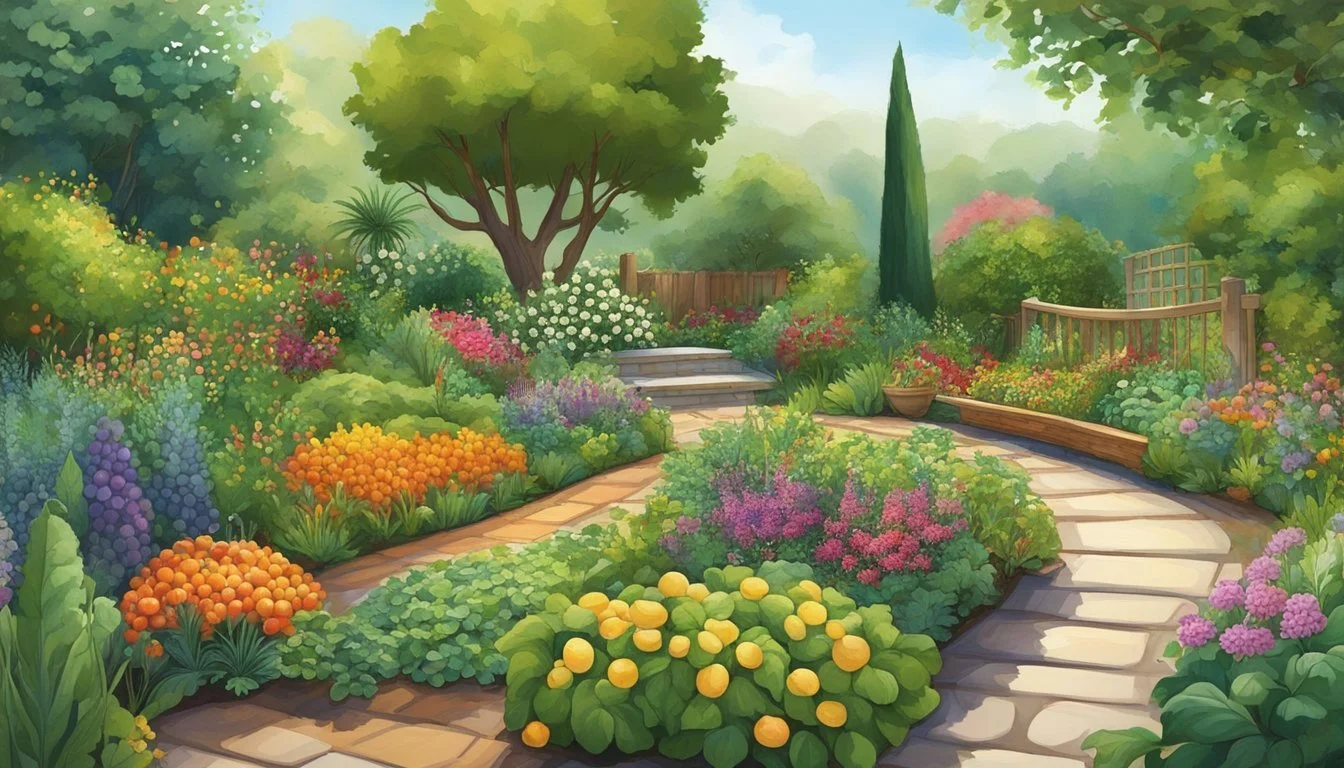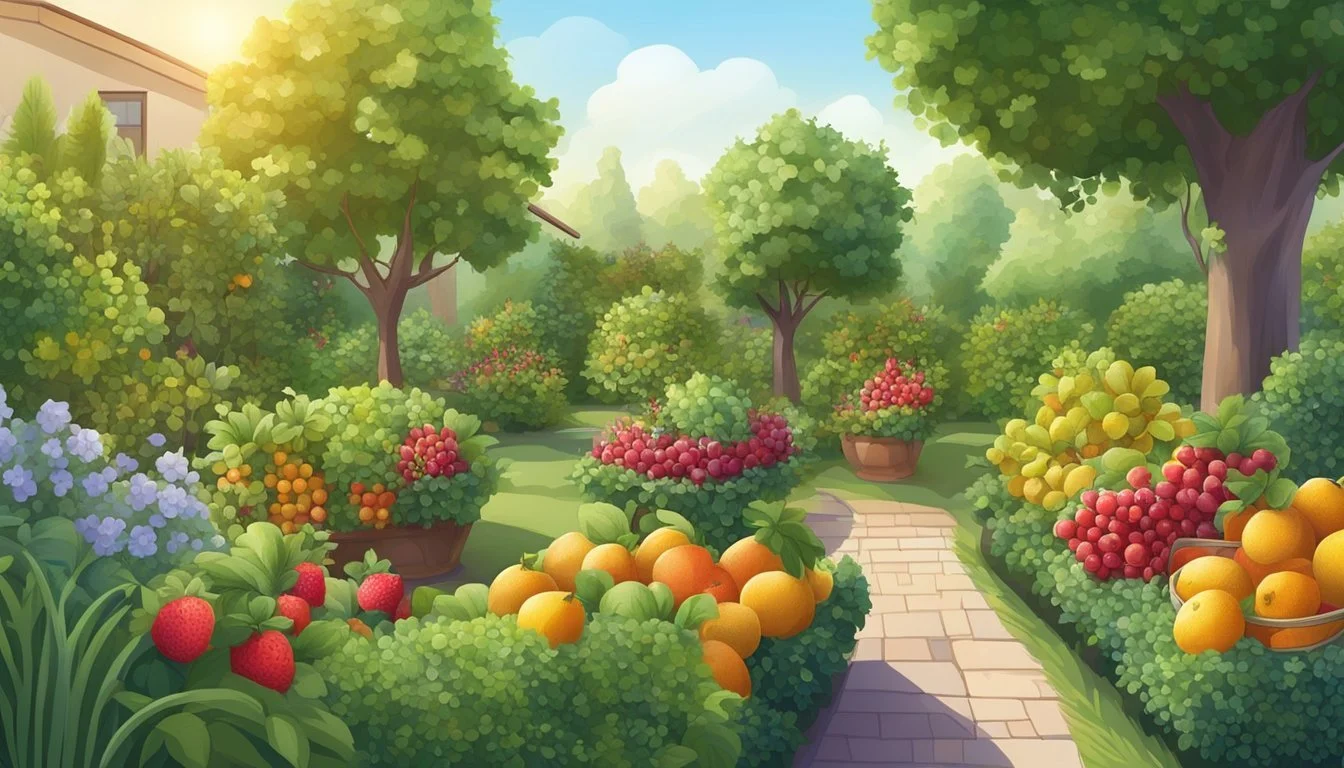Edible Landscaping
Aesthetic and Functional Approaches for Your Garden
Edible landscaping is an innovative approach to garden design that combines aesthetic beauty with practical functionality. This method of landscaping elevates the traditional garden by integrating food-producing plants into the layout, providing homeowners with both a sustainable source of fresh ingredients and an attractive outdoor space. By carefully selecting a variety of plants, such as fruits (What wine goes well with fruits?), vegetables, herbs, and even some nuts, gardeners can create a landscape that is both pleasing to the eye and beneficial to the palate.
The concept of edible landscaping is gaining traction among those who seek to make the most out of their gardens. This method encourages the fusion of ornamental and edible flora, allowing for a garden that serves dual purposes: enhancing the visual appeal of the property and contributing to a more self-sufficient lifestyle. With meticulous planning focused on climate-appropriate plant selection and garden aesthetics, a functional and thriving edible landscape can be established, which thrives throughout the year.
Edible Landscaping Essentials
Edible landscaping merges the beauty of traditional garden design with the practicality of growing edible plants. It represents an innovative approach to landscape design that can transform gardens into both visually pleasing and functional spaces.
Understanding Edible Landscaping
Edible landscaping is the practice of incorporating food-producing plants into the landscape design. Rather than focusing solely on aesthetics, it includes a variety of edible species that provide both nourishment and visual appeal. When planning an edible landscape, individuals must consider factors such as climate, soil conditions, and sunlight availability. It's not merely about planting food crops; it's about integrating them purposefully into the existing landscape in a way that enhances the overall garden design.
Benefits of Edible Landscaping
The advantages of integrating an edible landscape into one's garden are multifaceted:
Aesthetic Enhancement: Carefully selected edible plants can add color, texture, and structure to a garden, enriching its overall appearance.
Functional Value: Edible landscapes provide a sustainable source of fresh produce, reducing the need for store-bought fruits and vegetables.
Economic Efficiency: Growing one's own food can lead to significant savings on grocery bills over time.
Environmental Sustainability: Edible landscaping encourages local food production, reduces transportation emissions, and contributes to biodiversity.
This approach to landscape design not only appeals to those who appreciate the beauty of a well-designed garden but also to those aiming to achieve a more self-sufficient and sustainable lifestyle.
Designing Your Edible Landscape
Creating a harmonious blend of beauty and utility in a garden requires careful consideration of various design elements. One starts by assessing the climate and outdoor space to establish a practical and appealing edible landscape.
Planning and Zoning
The foundation of a successful edible landscape lies in understanding the climate and creating microclimates within the outdoor space. One must know which areas receive full sun and which are shaded, as this will influence plant selection and positioning. Incorporate biodiversity by zoning different textures, colors, and shapes to create visual appeal and promote a healthy garden ecosystem.
Choosing the Right Plants
Selection should be based on both aesthetic and functional qualities. Combine ornamental plants with edibles by choosing a mix of perennials and annuals that complement each other in growth habit and color. Gardeners should prioritize plant diversity to foster biodiversity, and pick species that not only thrive in their specific climate but also contribute to the overall visual appeal of the landscape design.
Cool Climate Zone: Perennials - Kale, Annuals - Lettuce
Temperate Climate Zone: Perennials - Rosemary, Annuals - Basil
Warm Climate Zone: Perennials - Chives, Annuals - Cilantro
Incorporating Aesthetics and Functionality
A robust edible landscape weaves functionality with aesthetic charm, blending textures, colors, and shapes to please the senses while serving a purpose. Clever use of borders, such as flowering herbs, can provide ornamental value while adding to the garden's productivity. Aim to mix plants that thrive together, using one to complement or enhance the texture and color of the other. This approach to landscape design ensures that the outdoor space is not only a source of fresh produce but also an area of stunning visual appeal.
Plant Selection
Selecting the right plants is crucial for creating an edible landscape that is both beautiful and bountiful. The focus should be on choosing varieties that will thrive in the local climate and soil conditions, while also delivering a pleasing visual impact and a rewarding harvest.
Cultivating Vegetable Varieties
When it comes to vegetables, one must consider factors such as sunlight, seasonality, and soil quality. Tomatoes are a favorite due to their versatile use and variety of striking colors. They require full sun and well-drained soil. Beans serve not only as a rich protein source but also bring vertical interest when grown on trellises. For those with limited space, lettuce and kale are compact and continue to provide produce over an extended period. Plan for a succession of crops to maintain continuous growth and harvest. For example:
Spring: Plant kale and lettuce for early harvest.
Summer: Transition to warm-season crops like tomatoes, peppers, and zucchini.
Fall: End the season with a second planting of leafy greens and beans.
Integrating Fruit Trees and Shrubs
Fruit trees and shrubs not only offer fresh produce but also serve as stunning landscape features. An apple tree can provide a shaded canopy and a spring display of blossoms, while a cherry tree's burst of delicate flowers can be a focal point. Diverse berry bushes such as blueberries and kiwi vines cover ground and vertical spaces while yielding delicious berries. Consider growing pear trees for their elegant form and long-lasting fruit. For integration into the landscape, use the following pattern.
Apple: Flowering Time - Early to Mid-Spring, Fruit Harvest Time - Late Summer to Fall
Cherry: Flowering Time - Mid-Spring, Fruit Harvest Time - Early to Mid-Summer
Blueberry: Flowering Time - Late Spring, Fruit Harvest Time - Mid to Late Summer
Pear: Flowering Time - Early Spring, Fruit Harvest Time - Late Summer to Fall
Adding Aromatic Herbs and Flowers
Incorporating herbs and edible flowers can add layers of scent and splashes of color. Herbs such as sage, rosemary, and oregano offer both culinary benefits and textural variety. Mint should be contained to prevent it from spreading uncontrollably. Edible flowers like nasturtiums contribute vibrant hues and a peppery taste to salads. Here's an example of how to use aromatic herbs and flowers in the garden:
Line pathways with sage and oregano for their fragrant leaves and pollinator-attracting flowers.
Edge gardens with rosemary; its needle-like foliage can be shaped into hedges.
Plant nasturtiums along borders or in hanging baskets for their showy, edible blooms.
Soil and Cultivation
Effective edible landscaping relies on a foundation of healthy soil and specific cultivation techniques. By enhancing soil fertility, embracing composting and mulching, and establishing efficient irrigation practices, a gardener can foster a productive and sustainable garden.
Building Fertile Soil
Soil quality is pivotal in the success of an edible landscape. A soil test can help determine the nutrient profile and pH level, allowing for the appropriate fertilizers and amendments to be applied. Optimally, soil should be rich in organic matter, well-aerated, and have good drainage to promote healthy root growth. Incorporating organic matter can improve soil structure and fertility.
Composting and Mulching
Composting is an essential sustainable practice for maintaining soil health. It involves the natural breakdown of organic material, resulting in nutrient-rich compost that can be added to the garden. Benefits of compost include improved soil structure, increased nutrient content, and enhanced moisture retention. Mulch, such as straw or wood chips, is applied to soil surfaces to conserve moisture, regulate temperature, and suppress weeds. Together, composting and mulching enrich the soil and promote a flourishing ecosystem within the garden.
Irrigation and Watering Practices
Proper watering is critical to the health of edible plants. Overhead sprinkling can be wasteful and promote disease, whereas drip irrigation targets the plant roots directly, reducing water usage and minimizing evaporation. Utilizing timers and moisture sensors can ensure plants receive the right amount of water at the right times, further enhancing irrigation efficiency. Developing a regular watering schedule that takes into account local climate, weather patterns, and plant needs is vital to conserve water and ensure plant vitality.
Maximizing Yields
Maximizing yields in edible landscaping requires strategic approaches to crop variety and maintenance practices. It focuses on optimizing productivity while ensuring longevity and abundance of homegrown produce.
Crop Rotation and Diversity
Crop rotation is crucial for maintaining soil health and preventing disease build-up. By changing the types of crops grown in a particular area each season, one can discourage pests and diseases that are specific to a crop. Diversity in planting is not just about different species, it also involves varying the plant families to reduce the chances of cross-related issues. For instance:
Year 1: Legumes (fix nitrogen in the soil)
Year 2: Leafy greens (use nitrogen and grow quickly)
Year 3: Fruit vegetables (need rich soil)
This cycle can help maintain soil fertility and keep pests at bay, ultimately boosting yields.
Maintaining and Harvesting
Proper maintenance includes regular practices such as pruning to enhance the growth habit of plants, allowing for increased sunlight exposure and air circulation. Raised beds can be significant assets in an edible landscape, not only for their ergonomic benefits but also for their ability to contain high-quality soil tailored to the needs of specific crops. The size and depth of the beds should be chosen based on the root requirements of the plants to maximize their growth.
Harvesting should be done regularly to encourage further production. Early and frequent harvesting can stimulate plants to increase their yield, thus giving a higher overall productivity. For example, cutting leafy greens often can prompt them to regrow more swiftly, providing a continual harvest. Efficient harvesting involves:
Knowing the peak harvest time for each crop
Using appropriate techniques that do not damage the plants
Storing harvested produce properly to maintain freshness
Observing local climatic conditions and selecting appropriate plant varieties for the area can lead to improved yield. Local, homegrown produce is more likely to thrive in the conditions for which it is adapted, mitigating many common issues before they arise.
Pest and Disease Management
Effective pest and disease management in edible landscaping is crucial for maintaining both the aesthetic appeal and productivity of the garden. Interventions should aim to be environmentally responsible, targeting specific problems while preserving the overall ecosystem.
Pest Control Strategies
Manual Control: For small infestations, one can physically remove pests such as aphids and caterpillars from plants. Beneficial Insects: Introducing predators like ladybugs can help control pest populations naturally. Cultural Practices: Utilizing trellises for climbing plants can reduce pest access and promote air circulation which deters fungal growth. Pesticide Use: If required, targeted application of pesticides, preferably organic, can provide relief from persistent pests. Remember to apply according to the label directions to minimize ecosystem disruption.
Disease Prevention and Treatment
Preventative Measures: Selection of disease-resistant plant varieties and rotation of crops can significantly reduce disease incidence. Environmental Control: Ensuring proper spacing between plants and watering at the base rather than overhead can reduce moisture-borne diseases. Organic Treatments: Neem oil and sulfur are examples of organic options that can treat specific diseases without harming beneficial insects. Chemical Controls: When organic methods are insufficient, judicious use of fungicides and bactericides can be a last resort. Monitoring and immediate action at the first sign of disease are essential to prevent its spread.
Wildlife and Pollination
Edible landscaping serves as a dual-purpose gardening strategy that enhances the environment by inviting a variety of pollinators and wildlife. This approach plays a crucial role in bolstering local ecosystems and biodiversity.
Attracting Pollinators and Wildlife
Incorporating plants that are attractive to pollinators can significantly increase the productivity of your garden. Bees, including both wild species and domesticated honeybees, are key agents of pollination. They are attracted to a variety of flowering plants, particularly those that produce ample nectar and pollen. Berry shrubs, for instance, not only contribute to a garden's aesthetics but also offer vital resources for these insects.
To encourage a range of beneficial insects, one might consider the following:
Flowers: Plant diverse types of flowers, particularly native species, which bloom at different times of the year.
Habitats: Leave some areas of the garden wild to offer shelter and nesting sites for wildlife.
Water Sources: Provide clean water sources such as a shallow bird bath or a small pond to help wildlife thrive.
Creating a Balanced Ecosystem
A balanced ecosystem within an edible landscape involves creating an environment where biodiversity thrives. The presence of beneficial insects, like ladybugs and lacewings, contributes to the control of pest populations, reducing the need for chemical interventions.
By fostering a diverse array of plant life, one can support the following:
Ecological Stability: A variety of plants leads to a more stable ecosystem capable of withstanding pests and diseases.
Soil Health: Different plants contribute to soil fertility through their varied root structures and leaf litter.
Remember, a well-planned edible landscape can attract a wealth of pollinators and beneficial insects that ensure healthy plant growth and a robust ecosystem.
Sustainability Practices
Incorporating edible landscaping is a testament to sustainable living, intertwining eco-friendly garden solutions with carbon footprint reduction to foster environmental stewardship.
Eco-Friendly Garden Solutions
Landowners can employ a variety of eco-conscious strategies to improve their garden's sustainability. Edible ground cover, such as creeping thyme or alpine strawberries, provides a dual-purpose solution that enhances soil health while yielding harvestable produce. Through composting, organic waste transforms into nutrient-rich soil, closing the nutrient loop and reducing the need for chemical fertilizers. This method showcases a cycle of sustainability: garden waste returns to the earth, not as refuse, but as a resource.
Ground Cover: Alpine strawberries, creeping thyme
Composting Benefits:
Enriches soil
Suppresses plant diseases and pests
Reduces the need for chemical fertilizers
Reducing Carbon Footprint through Gardening
One's carbon footprint diminishes considerably when integrating food-producing plants into local landscapes. Transport emissions are significantly reduced when food is grown at home rather than being transported from distant sources. This shift towards local production cuts down on greenhouse gas emissions associated with transportation and storage. Additionally, gardens absorb carbon dioxide, which aligns with the goal of a stable and sustainable environment.
Benefits of Localized Food Production:
Reduces transport emissions
Lowers energy consumption for food storage
Gardening practices in edible landscaping marry the aesthetics of design with the ethics of environmental care, thereby demonstrating that beauty and utility can work in concert for a healthier planet.
Garden Structures and Supports
In an edible landscape, structures like trellises and raised beds do more than just support plants; they can enhance both the beauty and yield of a garden. They serve specific roles, from providing vertical space for climbing plants to improving soil drainage and ergonomics.
Incorporating Trellises and Arbors
Trellises and arbors offer vital support for climbing plants such as beans, peas, cucumbers, and certain grape vines. A well-placed trellis can become a living wall, laden with edible produce. Similarly, arbors create inviting garden entrances and shady nooks, perfect for integrating with the aesthetic of an edible landscape. Consider the following for effective use:
Material Choice: Select materials that complement your garden aesthetically and are durable enough to endure the weight of mature plants.
Placement: Position trellises and arbors in areas that not only suit the garden's design but also meet the light and air circulation requirements of the chosen plants.
Utilizing Containers and Raised Beds
Containers and raised beds cater to an edible garden by offering a controlled environment for soil management and ease of maintenance. Raised beds elevate the root systems of edible plants, facilitating better drainage and less bending for gardeners during planting and harvest. Containers, on the other hand, allow for flexibility in moving plants and adjusting exposures. They are particularly useful for those with limited space. Key considerations include:
Size and Depth: Ensure containers and raised beds are large enough to accommodate the root systems of your chosen crops.
Material Selection: Use materials that are safe for food production and can withstand the elements, like untreated wood or food-safe plastics.
By carefully choosing and positioning supportive structures within an edible landscape, gardeners can optimize their space for both form and function.
Aesthetic Considerations
In the realm of edible landscaping, aesthetic considerations ensure that gardens are not only productive but also visually engaging. The right blend of color, textures, and thoughtful design contribute significantly to the aesthetic appeal of a garden space.
Visual Appeal through Seasonal Changes
A dynamic edible landscape takes into account the seasonal changes that plants undergo. By selecting a variety of plants that flourish and change at different times of the year, one can create a garden that maintains visual interest throughout each season. For instance, planting deciduous fruit trees alongside evergreens can provide a striking contrast between the bare branches of winter and the lush greenery of summer.
Integrating Colors and Textures
The integration of colors and textures is critical for creating a visually stunning edible landscape. A well-planned color scheme can be achieved by planting a spectrum of edible flowers like marigolds, which offer a vibrant burst of orange and yellow hues. Incorporating a mix of leaf textures—from the glossy, dark green leaves of a pepper plant to the feathery fronds of carrot tops—adds depth and contrast to the visual design.
Longevity and Maintenance
The successful integration of edible plants into the landscape requires thoughtful selection and dedicated care to ensure the garden’s longevity. Proper maintenance practices are critical for the continued health and productivity of the garden.
Perennial vs. Annual Choices
Perennials are plants that live for more than two years, offering lasting structure and less frequent replanting. They tend to require less annual maintenance once established, but a well-planned mix in the garden can optimize space usage and yield. Annuals, however, complete their life cycle in one year and must be replanted each season, which can be more labor-intensive. To maintain an edible landscape, one should balance perennials and annuals based on their maintenance needs and the desired longevity of the garden's elements.
Pruning and Long-Term Care
Pruning is essential for the long-term health of both perennial and annual plants. It stimulates growth, improves yield, and enhances the garden's appearance. Long-term care for perennials involves regular pruning to remove dead or diseased wood and to shape the plant, which can prevent future maintenance issues. Annuals may require less frequent pruning, but removing spent blooms and diseased foliage can extend their productivity within their growing season. Regardless of the plant type, consistent care and observation can prevent small issues from becoming larger problems.








